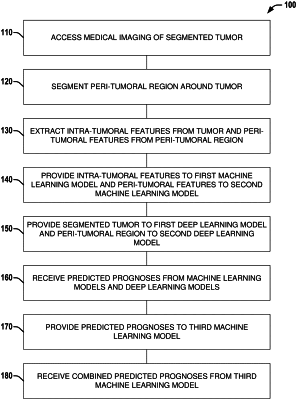| CPC G06T 7/0012 (2013.01) [G06F 17/16 (2013.01); G06N 20/10 (2019.01); G06T 7/11 (2017.01); G06V 10/255 (2022.01); G06V 10/764 (2022.01); G06V 10/771 (2022.01); G06V 10/774 (2022.01); G06V 10/776 (2022.01); G06V 10/809 (2022.01); G06V 10/82 (2022.01); G06T 2207/20081 (2013.01); G06T 2207/20084 (2013.01); G06T 2207/30096 (2013.01); G06V 2201/03 (2022.01)] | 32 Claims |

|
32. A method, comprising:
extracting a first set of radiomic features from a tumor segmented in a medical imaging scan and a second set of radiomic features from a segmented peri-tumoral region around the segmented tumor;
providing the first set of radiomic features to a first machine learning model and the second set of radiomic features to a second machine learning model;
providing the segmented tumor to a first deep learning model and the segmented peri-tumoral region to a second deep learning model;
receiving a first predicted prognosis for the tumor from the first machine learning model, a second predicted prognosis for the tumor from the second machine learning model, a third predicted prognosis for the tumor from the first deep learning model, and a fourth predicted prognosis for the tumor from the second deep learning model;
providing the first predicted prognosis, the second predicted prognosis, the third predicted prognosis, and the fourth predicted prognosis to a combination learning model; and
receiving a combined predicted prognosis for the tumor from the combination learning model.
|